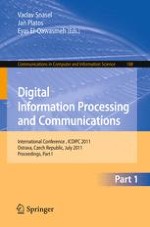This two-volume-set (CCIS 188 and CCIS 189) constitutes the refereed proceedings of the International Conference on Digital Information Processing and Communications, ICDIPC 2011, held in Ostrava, Czech Republic, in July 2011. The 91 revised full papers of both volumes presented together with 4 invited talks were carefully reviewed and selected from 235 submissions. The papers are organized in topical sections on network security; Web applications; data mining; neural networks; distributed and parallel processing; biometrics technologies; e-learning; information ethics; image processing; information and data management; software engineering; data compression; networks; computer security; hardware and systems; multimedia; ad hoc network; artificial intelligence; signal processing; cloud computing; forensics; security; software and systems; mobile networking; and some miscellaneous topics in digital information and communications.
